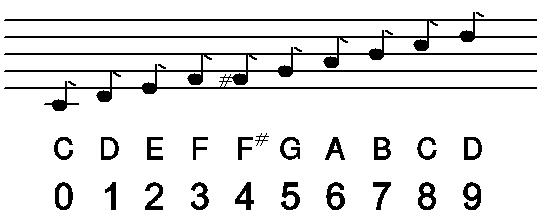
PIPPIN has a limited musical capability. You can play ten different notes with PIPPIN, the same as the first notes people learn to play on a recorder.
The notes are:-

They are played by pressing ![]() and then one of the number keys:-
and then one of the number keys:-
Note 0 gives C
Note 1 gives D
Note 2 gives E
Note 3 gives F
Note 4 gives F#
Note 5 gives G
Note 6 gives A
Note 7 gives B
Note 8 gives C one octave higher
Note 9 gives D one octave higher
To play several notes to make a tune, press
![]() and a number for each note.
and a number for each note.
For example, to play the first line of " Three Blind Mice" you do this :-
CM, ![]() ,
2,
,
2, ![]() ,
1,
,
1, ![]() ,
0,
,
0, ![]() ,
2,
,
2, ![]() ,
1,
,
1, ![]() ,
0, GO
,
0, GO
All the notes are the same length and there are no pauses between them. Most tunes will sound better if some of the notes are made longer (perhaps two or three times as long) and some pauses are put between them. Notes can be made longer by entering them several times or by putting them in a RPT/END loop. Each entry uses one program step, RPT and END take one step each, so up to 3 notes of the same value should be entered using notes, more than three could usefully be entered using RPT/END.
Pauses can be made any length by using a simple value. Pause 1 is about as long as a note, pause 2 is about as long as two notes etc.
You may sometimes need to use a note that is one octave above or below the note you wanted to use. This gives the best possible result given the limited number of notes available.
You will find that the number of program steps limits the possible tunes. Do not expect to be able to play a complete symphony!
The examples in this book have been adapted somewhat freely from the original to give the best sound on PIPPIN, you may be able to do better with some of them.
Rounds are particularly good for PIPPIN as they often allow repeats of entire sequences of notes. If you have access to more than one PIPPIN you could try using them to play different parts of a round.
Date Last Modified: 5/5/06 Copyright © 2006 Swallow Systems